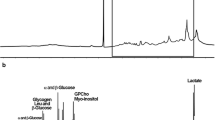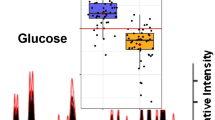Abstract
Objective
To investigate the plasma samples obtained from tumor patients using 1H nuclear magnetic resonance (NMR) spectroscopy, and find the biochemical foundation of abnormal Savda described in traditional Uyghur medicine.
Methods
A total of 170 tumor patients with abnormal Savda syndrome who were confirmed clinically were enrolled in this study, and 50 healthy volunteers were set up as controls. The plasma 1H NMR spectra were analyzed using the orthogonal projection to latent structure with discriminant analysis (OPLS-DA) method with unit variance scaling. The discriminative significance of the metabolites was determined using the Pearson’s product-moment correlation coefficient.
Results
Compared with the healthy controls, the tumor patients with abnormal Savda syndrome had uniformly correlative low levels of leucine, isoleucine, valine, histidine, tyrosine, alanine, glutamine, creatine, inositol, α-glucose, and β-glucose (P<0.05), but had significantly high levels of formate, malonic acid, acetone, acetate, acetoacetate, pyruvate, β-hydroxy butyrate, carnitine and lipidtemns such as very low density lipoprotein, low density lipoprotein and unsaturated lipids (P<0.05).
Conclusion
Tumor patients with abnormal Savda syndrome had similar metabolic changes and characteristics, which indicated a similar pathogenetic process and provides some biochemical basis for traditional Uyghur medicine theory.
Similar content being viewed by others
References
Upur H. Therapy of Mizaj and Hilit in Uyghur medicine and modern study. 1st ed. Urumqi: Xinjiang Science and Technology Publishing House; 2003:44–52.
Yusup A. Basic theory of Uyghur medicine. 1st ed. Urumqi: Xinjiang Science and Technology Publishing House; 1988:32–46.
Sabir M. Diagnostics of Uyghur medicine. 1st ed. Urumqi: Xinjiang Science and Technology Publishing House;1993:135–148.
Tohti K, Yusup A, Upur H. Comparative study of normal Hilit and abnormal Hilit described in traditional Uyghur medicine. J Med Pharm Chin Minorit (Chin) 2004;3:3–4.
Yusup A, Li L, Upur H, Upur T, Hasan H, Yusup B. Classify abnormal body fluid in Uyghur medicine and relationship with oxidation and antioxidation system. Chin J Basic Med Tradit Chin Med (Chin) 2004;10:61–62.
Kim YS, Maruvada P, Milner JA. Metabolomocs in biomarker discovery: future uses for cancer prevention. Future Oncol 2008;4:93–102.
Nicholson JK, Holmes E, Wilson ID. Gut microorganisms, mammalian metabolism and personalized health care. Nat Rev Microbiol 2005;3:431–438.
Mao HL, Xu M, Wang B, Wang HM, Ding XM, Lin DH. Evaluation of filtering effects of orthogonal signal correction on metabonomics analysis of healthy human serum 1H NMR spectra. Acta Chim Sin (Chin) 2007;65:152–158.
Wang YL, Tang HR, Nicholson JK, Hylands PJ, Sampson J, Holmes E. A metabolic strategy for the detection of the metabolic effects of Chamomile (Matricaria recutita L.) ingestion. J Agric Food Chem 2005;53:191–196.
Eriksson L, Johansson E, Kettaneh-Wold N, Wold S, eds. Multy- and megavariate data analysis: principles and applications. 1st ed. Sweden: Umetrics Academy; 2001:533.
Ishakjan. The encyclopedia of Uyghur traditional medicine. 1st ed. Urumqi: Xinjiang Science and Technology Publishing House;1985:17–33.
Upur H, Yusup A, Upur T, Hasan H, Wali A. The type of abnormal Hilit in traditional Uyghur medicine and its relation with age and gender. Chin J Etho Med Ethno Pharm (Chin) 2003;2:84–86.
Upur H, Yusup A, eds. The new theory of abnormal savda hilit in Uyghur medicine. 1st ed. Urumqi: Xinjiang People’s Publishing House; 2009:7–11.
Author information
Authors and Affiliations
Corresponding author
Additional information
Supported by the Program for Changjiang Scholar and Innovative Team (No. IRT0977)
Rights and permissions
About this article
Cite this article
Mamtimin, B., Upur, H., Hao, Fh. et al. Plasma metabonomic analysis with 1H nuclear magnetic resonance revealing the relationship of different tumors and the disease homology theory of traditional Uyghur medicine. Chin. J. Integr. Med. 17, 111–115 (2011). https://doi.org/10.1007/s11655-011-0638-x
Received:
Published:
Issue Date:
DOI: https://doi.org/10.1007/s11655-011-0638-x




